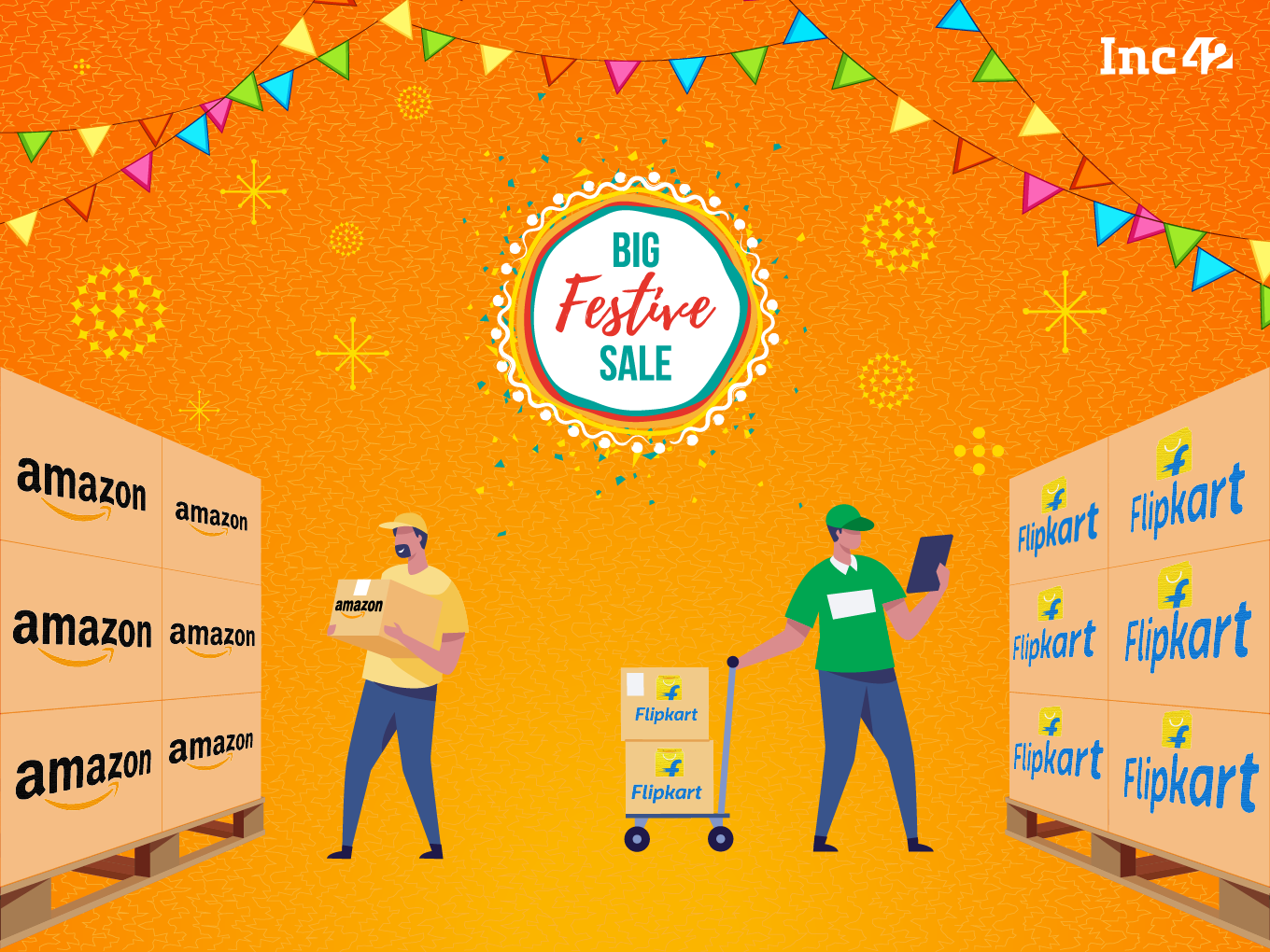SUMMARY
Despite the rise in sales of ecommerce players, an average user is spending a lesser amount during the current festive season
The number of online shoppers has almost remained stagnant over the last few years
From rising inflation to internet fatigue, multiple factors seem to be affecting ecommerce sales
With ecommerce giants like Amazon and Flipkart reporting sales of billions of dollars (nearly $3.5 Bn in cumulative gross merchandise value) during the first few days of the month-long festive season every year, the general perception is that Indians wait with bated breath to shop from online marketplaces during this period.
The Covid-19 pandemic was a tipping point which accelerated ecommerce adoption in the country. However, an average user is not only spending less in the 2022 festive season but also giving the online shopping experience a complete miss. At least that’s what the early trends from Amazon, Flipkart and other marketplaces indicate, stated by consulting firm, Redseer state.
There are two main reasons for this assumption. According to Ujjwal Chaudhry, partner at Redseer, the average user spend remained stagnant in 2022 at INR 5,200 per shopper after the first four days of the festive season sale. This is 41% and 30% lower than pre-Covid levels of 2018 and 2019, respectively.
Redseer estimates that the number of active shoppers this festive season will come to roughly 50 Mn-55 Mn, which is a massive 60% lower than 2020 when the shopper base was at 80 Mn.
Given that the first week of the festive season sales accounts for nearly 60% of the total volume, industry experts feel the picture in 2022 is not too optimistic for marketplaces, when it comes to a massive uptick in the number of shoppers or the total GMV.
“The number of customers hasn’t really increased, but basket size has decreased appreciably. This implies that we are reaching a cap in terms of active internet shoppers and the long tail is giving decreasing returns. This is a warning sign not just for ecommerce players but for the market in general. And this, for me, is the biggest takeaway,” Saurabh Parmar, a veteran marketing professional, told Inc42.
However, overall sales by ecommerce platforms are expected to rise by about 20-30% this year. The decline in average spending will be a matter of concern for sellers, not the marketplaces.
Manasvi Neyol, who manages Facebook ad optimisation for ecommerce enabler platform Adyogi, said that the pandemic has led to a behavioural shift in online shoppers. “While it has increased the number of online sellers by almost 2x, it has also changed consumer behaviour. The introduction of low-value catalogues, and emergence of Meesho and other marketplaces has spread the sales,” Neyol adds.
Festive Sales 2022: Low-Ticket Size Products In Demand
The decline in the average user spending on online shopping can be attributed to the inroads made by low-ticket size items like fashion and home decor in shopping carts.
According to a report by Snapdeal-owned ecommerce SaaS platform Unicommerce, ecommerce volume grew 28% during the first few days of the festive season. However, this was led by growth in the volume of categories with lower product prices.
The fashion category was dominant in the initial days of the festive season, with the highest order volumes. The category reported a 7% year-on-year growth in volume. Besides, other segments such as home decor, gifting products, furniture, and jewellery also witnessed strong growth during this festive season sale, according to Unicommerce.
Personal care, another low-ticket category, saw the fastest year-on-year (YoY) growth of over 70% in volume during the first two days of the festive season sale of 2022. Electronics (excluding mobile phones) was at the second position with 48% YoY growth, driven by sales of audio products and smart wearables. These products usually have lower prices than smartphones.
Besides, internet fatigue and the headwinds created by macroeconomic factors have also affected ecommerce sales. During Inc42’s recent D2C Summit 2022, WOW Skin Science cofounder Manish Chowdhary indicated that D2C brands are anticipating a 20%-30% decline in sales during the festive season.
Inflation Shrinks Ecommerce Sales
The rise in interest rates, growing retail inflation, and depreciation of rupee against dollar have not only impacted consumption patterns in the country but also created a bit of a marketing slowdown for brands. Retail inflation stood at 6.7% in July, well beyond the Reserve Bank of India’s tolerance level of 6%.
According to experts, the inflationary trend is likely to persist for some time, and the rise in price of commodities will impact purchasing decisions and demand.
However, the rise in retail inflation is expected to have minimal impact on consumers at the top of the pyramid (high-end buyers) who are likely to continue to spend big during the next few months. This is vindicated by the boom in premium smartphone sales during the ongoing festive season.
According to Redseer’s Chaudhury, smartphones worth $1.5 Bn were sold online during the first four days of the festive season this year, led by Apple iPhones and OnePlus phones. This was in contrast to the previous festive seasons when mid-priced smartphones led the sales.
Recurring Sales And Increasing Competition
While the draft ecommerce rules (2020) looked to tackle flash sales and deep discounting by Amazon, Flipkart and other marketplaces, the rules have not been implemented yet. This year, too, discounts offered by these marketplaces have been bigger than the previous years, with several more bank partners.
“However, the fact that marketplaces have multiple sales in a year does allow the consumer to wait. While festive season sales do generate excitement, an average buyer knows that the next sale would be around the corner,” Parmar said.
“The number of players have increased beyond Amazon & Flipkart (Reliance, Meesho & Tata)… this means that customers can pick and choose the deals based on platform and also credit card discounts,” according to Parmar.
“Given that each marketplace ties up with different banks, it would mean some customers who are buying high-ticket items or multiple items could explore other platforms depending on cashbacks or offers they get beyond the listed price. The competition has started slowly and steadily hurting the big two,” he added.
The pick up in offline sales can be another reason for subdued ecommerce sales this year. This is the first festive season in three years out of the shadows of the pandemic. There is an online shopping fatigue among customers and they are now willing to step out of their homes for shopping.
Praveen Khandelwal, General Secretary of Confederation of All India Traders (CAIT), told Inc42 that the retailers’ body is expecting a sales turnover of over INR 125 Cr during this festive season. This number may seem very insignificant when compared to the sales of Amazon and Flipkart, but there definitely seems to be internet fatigue among customers.
“The internet fatigue has definitely set in, but the growth story of India’s ecommerce industry is going strong,” Chowdhary of Wow SKIN Science said.
While a clearer picture of the buying appetite among online shoppers will only emerge by the end of the festive season month, the initial trends are clearly not in alignment with the ecommerce boom witnessed in India during the past 2-3 years. However, the world’s second-largest internet market with 500 million active smartphone users continues to remain a huge ecommerce market ready for disruption. This will result in higher competition, attractive discounts, and, of course, regulatory headwinds going ahead.



























